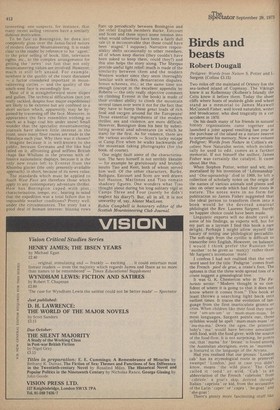High charade
Robin Campbell Everest South West Face Chris Bonington (Hodder and Stoughton, £3,95) Interviewer: Why are you going to climb the South .,,vest Face of Everest?
Bonington: Because it offers an interesting Mountaineering challenge: to do it will involve technically difficult climbing tlt an altilude requiring Constant use of oxygen, thus posing extraordinary logistic problems of supply and support.
Most of us will prefer Mallory's answer, but the occasion for it has passed. Poor Bonington had to, choose between the one given in the book (and paraphrased above) or the blunt honesty of ' Because it's all that's left there ' or the subtler, less palatable truth of Because I've sold a book about it.'
This last reason illustrates the paradoxical nature of South West Face. In fact, it is a new art form — a work of imagination upon which facts are based! Unlike other novels of fact such as Norman Mailer's this one was conceived, planned and sold before the ' events ' described occurred. Bonington and his men then went to Everest to follow the plot as best they could, eventually returning to complete the book in accordance with what actually naPPened. The climbers may not see it in this w,ay, but given their financial circumstances, the eventual existence of the book was a necessary condition for a successful expedi
,tion, and not conversely, so the issue of logical priority is clear. Thus, the events on
the mountain should be seen as an outgrowth Of the book (and other media "objects). Of course, this topsy-turvy pseudonews not a new phenomenon, nor confined to moon
taineering: one suspects, for instance, that many recent sailing ventures have a similarly dubious motivation.
To be fair to Bonington, he does not completely gloss over the Janus-faced nature of modern Greater Mountaineering. It is made clear to the reader by reference to his ' agent,' to the prior selling of book, film, television rights, etc., to the complex arrangements for getting the ' news ' out fast that not only mountaineering values are involved. However, much is still left unsaid. For example, nowhere is the quality of the route discussed — a factor considered important in mountaineering circles — and the quality of the south-west face is exceedingly low.
Most of it is straightforward snow slopes and gullies. The technical difficulties (not yet really tackled, despite four major expeditions) are likely to be extreme but are confined to a short section which, apparently, may be bypassed by traversing off the face. Moreover, in appearance the face resembles nothing so much. as a huge coal bin under snow! Small wonder that the specialist mountaineering journals have shown little interest in the route, since many finer routes are made in the Himalaya each year. Why then was it chosen? 1 imagine because it is well-known to the public, because Germans and the like had failed on it, affronting good selfless British chaps like Whillans in the process with offensive nationalistic displays, because it is the only new route left to Everest from the Khumbu glacier (the only presently-available approach): in short, because of its news value.
The standards which must be applied to South West Face are therefore those which apply to any contemporary adventure thriller. How has Bonington coped with plot, characterisation, tempo, etc., bearing in mind that the expedition was a total failure due to impossible weather conditions? Pretty well, under the circumstances. The story has a good deal of human interest: blazing rows
flare up periodically between Bonington and the other English members Burke, Estcourt and Scott and these inject some tension into what would otherwise have been a fairly dull tale (it is inconceivable that these could have been 'staged,' I suppose). Narrative responsibility shifts occasionally to other members, all of whom keep diaries (they couldn't have been asked to keep them, could they?) and this also helps the story along. The Sherpas provide useful light relief: much is made of the similarity between them and the modern Western worker since they seem thoroughly familiar with strikes, demarcation disputes, bonus schemes, etc.; at the same time not enough (except in the excellent appendix by Roberts — the only really objective comment on climbing Everest in the book) is made of their evident ability to climb the mountain several times over were it not for the fact that they have to hump these great loads of rich food and oxygen around for the Europeans! Those essential ingredients of the modern thriller, sex and violence, are more difficult. However, Bonington does his best by substituting several anal adventures (in which he stars) for the first. As for violence, there are , the various accidents — Scott's lucky escape at Camp Five when he walks backwards off the mountain taking photographs (for the book, of course).
One might fault some of the characterisation. The hero himself is not terribly likeable — for example he gratuitously and brutally insults Tiso and Kent, both of whom served him well. Of the other characters, Burke, Bathgate, Estcourt and Scott are well drawn but Haston, MacInnes and Tiso remain shadowy figures. One wonders what Tiso thought about during his long solitary vigil at Camps Three and Four (surely he didn't neglect his diary?). But, all in all, it is not unworthy of, say, Alister MacLean.
Robin Campbell is honorary editor of the Scottish Mountaineering Club Journal.











































 Previous page
Previous page